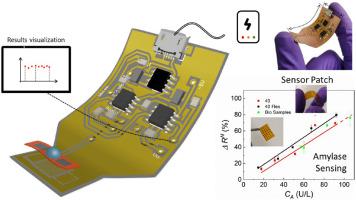Biosensors and Bioelectronics ( IF 10.7 ) Pub Date : 2020-06-11 , DOI: 10.1016/j.bios.2020.112333 Mitradip Bhattacharjee 1 , Sagnik Middya 2 , Pablo Escobedo 3 , Joydip Chaudhuri 4 , Dipankar Bandyopadhyay 5 , Ravinder Dahiya 3

|
Concentration of α-amylase in human serum is a key indicator of various pancreatic ailments and an affordable point-of-care detection of this biomarker can benefit millions suffering from these diseases. In view of this situation, we report the development of a flexible patch-sensor, which simply requires a microdroplet of aqueous starch-FeSO4 solution to detect α-amylase in serum. The detection is achieved through the generation of mixing vortices (~12 rpm) inside the droplet with the help of an imposed thermal gradient. Such vortices due to Marangoni and natural convections are found to be strongest at an optimal temperature difference of ~18 °C – 23 °C across the droplet which in turn facilitate mixing and promote the specific starch-amylase enzymatic reaction. Subsequently, the large (~80%) variation in the electrical resistance across the droplet is correlated to detect the level of the α-amylase in the analyte. Importantly, the sensor can detect even in the limits of 15–110 units/liter. Further, the sensitivity of flexible sensors is ~8.6% higher than the non-flexible one. Interestingly, the sensitivity of the proposed sensor has been nearly three-times than the previously reported optical ones. The results of patch-sensor match very closely with the standard path-lab tests while detecting unknown level of amylase in serum. The prototype has shown significant potential to translate into an affordable device for the real-time detection and easy prognosis of pancreatic disorders.
中文翻译:

基于微滴的一次性传感器贴片,用于检测人血清中的α-淀粉酶。
人血清中α-淀粉酶的浓度是各种胰腺疾病的关键指标,对该生物标记物的价格合理的即时检测可以使数百万罹患这些疾病的人受益。鉴于这种情况,我们报告了一种柔性膜片传感器的开发,该传感器仅需要一小滴淀粉状硫酸铁FeSO 4即可。血清中检测α-淀粉酶的溶液。通过施加的热梯度通过在液滴内部产生混合涡流(〜12 rpm)来实现检测。人们发现,由于马兰戈尼和自然对流引起的这种涡流在整个液滴的最佳温度差为〜18°C – 23°C时最强,这又有利于混合并促进特定的淀粉-淀粉酶的酶促反应。随后,将液滴上的大(〜80%)电阻变化关联起来,以检测分析物中的α-淀粉酶水平。重要的是,传感器甚至可以检测到15-110单位/升的极限。此外,柔性传感器的灵敏度比非柔性传感器的灵敏度高〜8.6%。有趣的是 所提出的传感器的灵敏度已经是以前报道的光学传感器的近三倍。膜片传感器的结果与标准的路径实验室测试非常吻合,同时检测到血清中淀粉酶的水平未知。该原型已经显示出巨大的潜力,可以转化为可负担的设备,用于实时检测和轻松预测胰腺疾病。











































 京公网安备 11010802027423号
京公网安备 11010802027423号